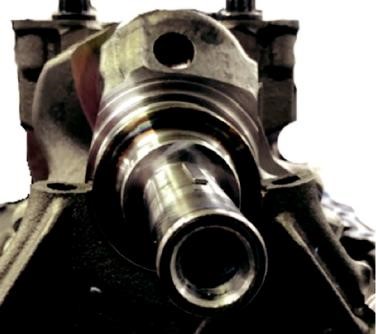We have been machining crank housing bores and connecting rods for ages. When it comes to sizing those bores, it used to be pretty straight forward. You cut the cap to reduce the diameter and hone the housing back to the correct diameter.
Today, we are pretty familiar with fractured cap rod but now there are fractured cap blocks. One example of that technology is the 2.7 Ford Ecoboost which is also a Compacted Graphite Iron block. We spoke of CGI in an earlier edition of Engine Professional Magazine and I made the comment that CGI is probably reserved for performance and heavy duty and likely would not trickle down to production gas engines. I spoke too soon as the Ecoboost family most definitely is not diesel and by the way we classify vehicles, light duty.
So, how are machine shops going to deal with this challenge? This is not really new to the PER’s or Production Engine Rebuilders. They started using OSOD (oversized outside diameter) bearings as more and more fractured cap rods were being released. Now, we have that strategy figured out, we need to make sure that we are notifying our suppliers of what we are seeing so that they can get these OSOD bearings developed, catalogued and in inventory.
Are there other advantages to using an OSOD bearing? If you have ever honed anything, you know that the closer the bore is to round, the easier it is to maintain a round bore. If you can re-size connecting rods or other housing bores without having to cut caps, not only are you saving time, you can be assured that issues like non-clean up at the parting line are eliminated.
Is there a concern with the area that does not hone when cutting caps? We know that we have successfully honed shaft housing for many years in that manner and I am not going to say that it is bad. I am saying that you can improve by using an OSOD bearings. With an OSOD bearing, you are given a better opportunity to ensure that the bearing back will have maximum contact with the housing bore.
For any bearing to perform optimally, you need the housing to meet the following parameters.
1) Correct surface finish to ensure adequate heat transfer between the bearing shell and the mating component. You have to be careful not to be too coarse or oil can migrate behind the bearing causing “coking” or the oil to become glass like. Glass is a poor heat conductor as is minimized metal to metal contact.
2) Correct surface finish to aid in bearing retention. Some traction if you will. Too smooth can allow movement which can lead to false brinelling or micro-welding.
3) Diameter influences bearing crush. Proper crush height coupled with proper surface roughness retains our bearing. An out of round housing may not maintain the bearing shape well enough to yield the correct eccentricity for the application. The bearing has eccentricity produced at manufacturing. Bearing housing with eccentricity may result in greatly varied amounts of eccentricity throughout the lube circuit.
By Chuck Lynch. Read the full story here:


